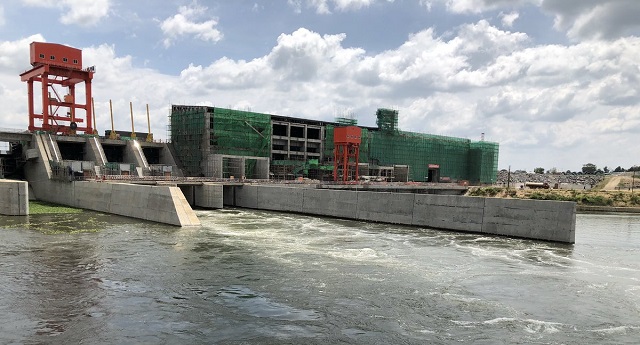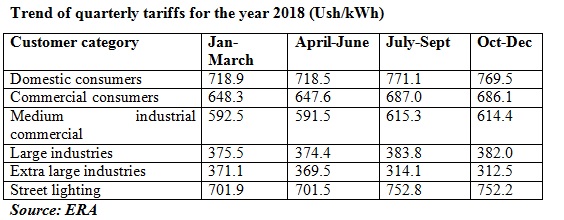
Government hopes new dams will drive tariffs downwards
Kampala, Uganda | JULIUS BUSINGE | Electricity consumers grappling with surging energy bills have at least got some relief as the industry regulator reduces tariffs for the next three months. But they are not overall better off, compared with four years ago.
The Electricity Regulatory Authority’s latest power tariff plan shows a reduction in tariffs by an average of 1.5% for domestic, industries and street lighting consumers for the period ending December 2018.
The new tariff plan for the quarter under review released on Oct.04 will see domestic consumers pay Shs769.5 down from Shs771.1 kWh, with commercial consumers paying Shs686.1, down from Shs687 per kWh.
Similarly, medium industrial consumers will pay Shs614.4 down from Shs615.3 per kWh; large industries Shs382, down from Shs383.8kWh; extra-large industries Shs312.5, down from Shs314.1 kWh whereas street lighting will pay Shs752.2, down from Shs752.8 per kWh during the same period under review.
The reduction, according to the regulator, was as a result of improved performance in the key economic indicators of inflation, fuel prices and the exchange rate.
But this new tariff is higher than that of 2014, signaling a continued surge in electricity bills and lowering industrial sector’s competitiveness in the region.
In 2014, domestic consumers paid an average of Shs518 per kWh while commercial consumers paid an average of 471.8 per kWh. Medium industrial consumers paid Shs449.4 per kWh, large industrial consumers Shs 307.8 per kWh and street lighting Shs486.2 per kWh.
Speaking to The Independent in an interview on Oct. 12, the new Board Chairman of Uganda Breweries Limited (UBL), Japheth Kato, said they welcome the reduction in electricity tariffs but added that more reductions are important since they use a lot of power in the beer production.
“…as you can imagine anything that can reduce the cost of production which in turn would make our products more affordable we support completely,” Kato said adding “we like government initiative of investing heavily in power to support our activities.”
UBL, a subsidiary of East Africa Breweries Limited, is the producer of Bell Lager, Uganda Waragi and Tusker beer brands.
This comes as the Private Sector Foundation Uganda Executive Director, Gideon Badagawa, says most businesses involved in different trade incur 20% as energy cost of the total production, leading to a surge in prices of final products to the consumers.
He said more effort need to be geared towards increasing demand by attracting and connecting more investments or consumers so that the cost goes down.
Low electricity tariffs in offing?
Daniel Birungi, the executive director for Uganda Manufacturers Association (UMA) told The Independent on Oct.05, that government has promised to give them a written confirmation trajectory showing how the US$5cents per kWh as cost of power from the current US$ 8.3 cents per kWh would be achieved once more electricity is added to the national grid.
The government plans to switch on 183MW Isimba and 600MW Karuma hydropower dams and other small dams starting next year.
Birungi said that government has also given them confirmation that manufacturers would work with the electricity distributor, Umeme, to ensure that in areas where their members have multiple meters, they would combine them and have one to be able to increase consumption for the group and make them enjoy benefits of lower tariffs for large consumers.
Birungi said a reduction in production cost will stir industrial growth, which has been grappling with high electricity costs for years.
In a speech read by Finance Minister Matia Kasaija at the recently concluded UMA 2018 International Trade Fair, President Yoweri Museveni said that reducing electricity costs is in line with government’s efforts of prioritizing manufacturing under Vision 2040.
He said that the idea is to have 50% of Ugandan exports being manufactured goods – a move that would create more jobs and earn the country foreign exchange.
“With more power projects coming onboard, the cost of power shall continue to reduce until we realize the US5cents per kWh for all manufacturers,” Museveni said before tasking the Ministry of Energy and ERA to provide a trajectory showing the reduction in power tariffs to US5 cents per kWh to manufacturers.
10 year plan
Harrison Mutikanga, the chief executive officer for the Uganda Electricity Generation Company Limited says Uganda aims to generate 17,000MW of electricity in the next 10 years to match with the anticipated growth in demand.
The country’s access to electricity is estimated at about 20% of the country’s 34.9million people, according to Uganda Bureau of Statistics. The annual average electricity consumption stands at 80kWh per capita which translates into suppressed demand of over 500MW out of the around 955MW available on the national grid.
Mutikanga said that if this demand is un-locked through the new government electricity connection policy (2018-2027) with an annual target of providing 300,000 free on-grid connections, it is likely that the whole of Karuma (600MW) could be exhausted by 2028.
The Minister of Energy and Mineral Development, Irene Muloni, revealed that the government is extending power to industrial parks, implementing the new free connection policy, fast tracking of rural electrification through electrification of the 491 Sub Counties and extending high voltage interconnections within the East African Region as a business to grow revenue and increase electricity consumption.
However, she decried acts of vandalism of electrical installations which she said was interfering with the electricity supply network causing blackouts and driving upwards electricity tariffs and thus negatively impacting economic activities.
The growth in the economy is also expected to drive demand for electricity consumption. A 2015 report on Powering Africa, McKinsey and Company, experts in electric and natural gas revealed that there is a direct correlation between economic growth (GDP per capita) and per capita electricity consumption.
They say Sub-Saharan Africa is starved for electricity and that the region’s power sector is significantly underdeveloped going by energy access, installed capacity, or overall consumption.
“The fact that Sub-Saharan Africa’s residential and industrial sectors suffer electricity shortages means that countries struggle to sustain GDP growth,” the report reads in part.
It adds that fulfilling the economic and social promise of the region, and Africa in general depends on the ability of government and investors to develop the continent’s huge electricity capacity.

 The Independent Uganda: You get the Truth we Pay the Price
The Independent Uganda: You get the Truth we Pay the Price


